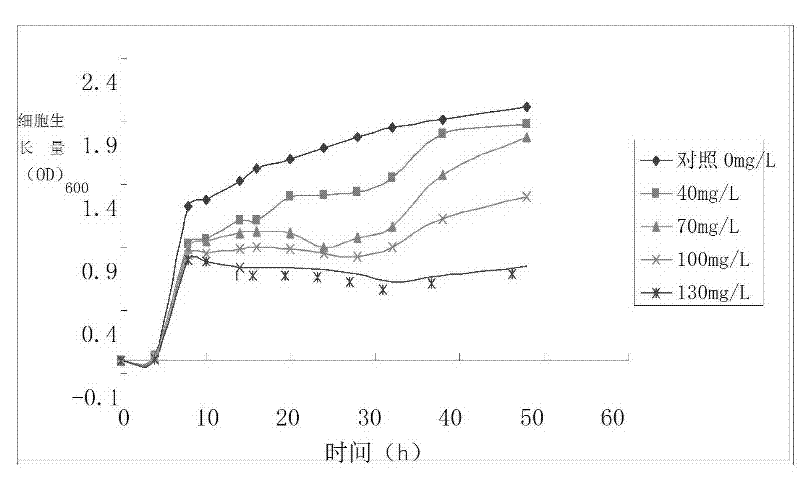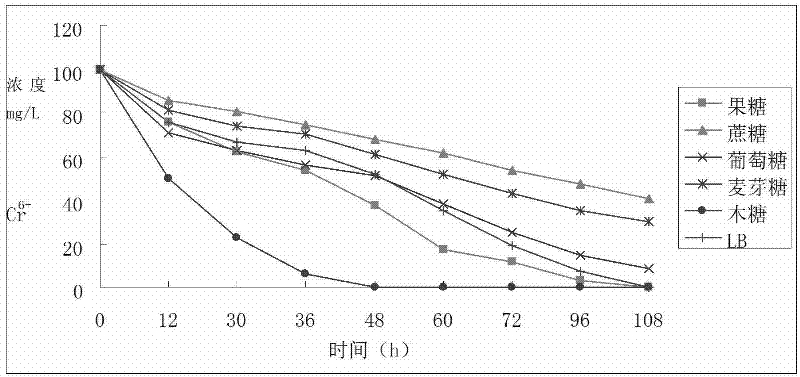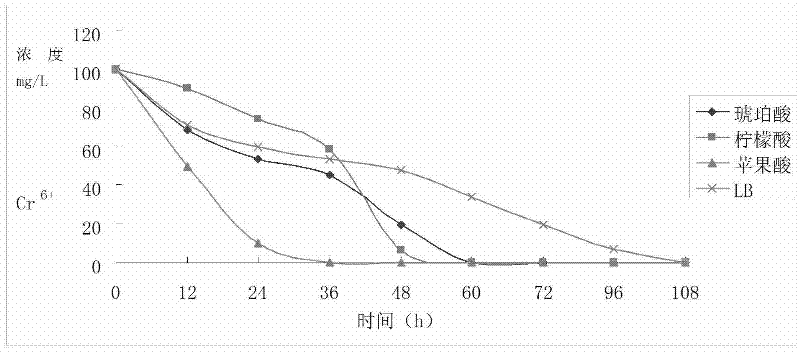Reductive chromium ion bacillus thuringiensis YB-03 and cultivation method and application of reductive chromium ion bacillus thuringiensis YB-03
A technology of Bacillus aureus, YB-03, applied in reducing chromium ion Bacillus thuringiensis YB-03 and its cultivation method and application field
- Summary
- Abstract
- Description
- Claims
- Application Information
AI Technical Summary
Problems solved by technology
Method used
Image
Examples
Embodiment 1
[0024] Example 1 Isolation and screening of hexavalent chromium-reducing bacteria
[0025] Take 10g of activated sludge (collection time: September 2010; collection location: Zhengzhou Wulongkou Sewage Treatment Plant; collection person: Wei Fei) in 90ml of sterile water, and dilute to 10 -1 ~10 -6 Six gradients. Take 1ml of the solution from each gradient and spread it on 6+ LB solid medium, cultured at 37°C for 24h.
[0026] Reductive identification of chromium-resistant bacteria: select colonies from the culture medium containing 100mg / L Cr 6+ In LB liquid medium, cultured at 37°C, 150r / min for 24h, took out an appropriate amount of solution and centrifuged to get the supernatant, and measured the remaining Cr in the solution 6+ content.
[0027] A total of two strains with different morphology were obtained in this screening and culture, which were named YB-01 and YB-03 respectively. The reducing effects of the two strains on hexavalent chromium are shown in Table 1....
Embodiment 2
[0031] Identification of embodiment 2 YB-03 bacteria
[0032] (1) Physiological and biochemical identification: Physiological and biochemical identification was carried out according to the "Bergey's Bacterial Identification Manual", and the results are shown in Table 2.
[0033] Table 2: Physiological and biochemical results of YB-03 bacteria
[0034]
[0035] (2) 16srDNA identification: The total bacterial DNA was extracted by alkaline lysis method, and PCR was performed with 16srDNA universal primers.
[0036] Universal primer: 16s-F: 5'-AGAGTTTGATCCTGGCTCAG-3' (see SEQ ID NO.2)
[0037] 16s-R: 5'-AAGGAGGTGATCCAGCCGCA-3' (see SEQ ID NO.3)
[0038] PCR system: 2×Mix: 25ul; upper primer: 1ul; lower primer: 1ul; template: 1ul; ddH 2 O: 22ul
[0039] The PCR program was as follows: first, pre-denaturation at 94°C for 5 min, and then cycled: DNA denaturation at 94°C for 30 seconds, annealing at 55°C for 30 seconds, extension at 72°C for 1 minute, 30 cycles, and finally ex...
Embodiment 3
[0042] Embodiment 3 YB-03 bacterial resistance test
[0043] (1) will K 2 Cr 2 o 7 , AgNO 3 , HgCl 2 , Cu(SO 4 ) 2 , Zn(SO 4 ) 2 , CoCl 2 , MnCl 2 Configure mother liquors of various required concentrations, filter and sterilize with a sterile 0.45um filter, add to LB to make the medium contain metal ions of different concentrations, insert the reducing bacteria into the medium, 37°C, Shake at 150r / min for 24 hours, observe whether the bacteria grow, and record the highest concentration of reducing bacteria against metal ions.
[0044] As can be seen from Table 3, YB-03 bacteria except for Cr 6+ Ions are resistant, and also have varying degrees of resistance to other heavy metal ions.
[0045] Table 3: Resistance of YB-03 bacteria to metal ions
[0046]
[0047] (2) Add ampicillin, kanamycin, cephalosporin, streptomycin, tetracycline and hygromycin to the medium, and observe the resistance of the reducing bacteria.
[0048] It can be seen from Table 4 that YB-0...
PUM
 Login to View More
Login to View More Abstract
Description
Claims
Application Information
 Login to View More
Login to View More - R&D
- Intellectual Property
- Life Sciences
- Materials
- Tech Scout
- Unparalleled Data Quality
- Higher Quality Content
- 60% Fewer Hallucinations
Browse by: Latest US Patents, China's latest patents, Technical Efficacy Thesaurus, Application Domain, Technology Topic, Popular Technical Reports.
© 2025 PatSnap. All rights reserved.Legal|Privacy policy|Modern Slavery Act Transparency Statement|Sitemap|About US| Contact US: help@patsnap.com



